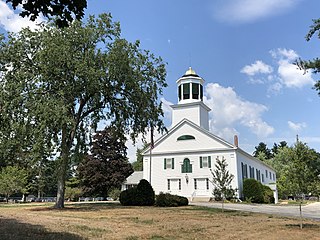
Merrimack is a town in Hillsborough County, New Hampshire, United States. The population was 26,632 as of the 2020 census.

Josiah Bartlett was an American Founding Father, physician, statesman, a delegate to the Continental Congress for New Hampshire, and a signatory to the Declaration of Independence and Articles of Confederation. He served as the first governor of New Hampshire and chief justice of the New Hampshire Superior Court of Judicature.

William Hooper was an American Founding Father, lawyer, and politician. As a member of the Continental Congress representing North Carolina, Hooper signed the Continental Association and the Declaration of Independence.
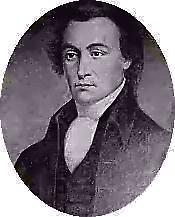
Matthew Thornton was an Irish-born Founding Father of the United States who signed the United States Declaration of Independence as a representative of New Hampshire.

William Williams was an American Founding Father, merchant, a delegate for Connecticut to the Continental Congress in 1776, and a signatory to the United States Declaration of Independence.

The Thomas Stone National Historic Site, also known as Haberdeventure or the Thomas Stone House, is a United States National Historic Site located about 25 miles (40 km) south of Washington D.C. in Charles County, Maryland. The site was established to protect the home and property of Founding Father Thomas Stone, one of the 56 signers of the United States Declaration of Independence. His home and estate were owned by the Stone family until 1936.
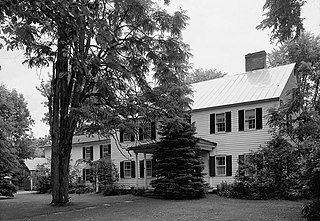
The Gen. William Floyd House is a historic house on Main Street at Gifford Hill Road in Westernville, New York. Built in 1803, it was the last home of Founding Father William Floyd (1734–1821), a signer of the Declaration of Independence, and a driving force in the settlement of the area. It was declared a National Historic Landmark in 1971. The house is a private residence, and is not normally open to the public.

The Huntington Homestead, also known as the Samuel Huntington Birthplace, is a historic house museum and National Historic Landmark at 36 Huntington Road in Scotland, Connecticut. Built in the early 18th century, it was the birthplace and boyhood home of Samuel Huntington (1731–1796), an American statesman and Founding Father. He served as a delegate to the Continental Congress, where he signed the Declaration of Independence. He also served as Governor of Connecticut and was the first presiding officer of the Congress of the Confederation, the first central government of the United States of America.
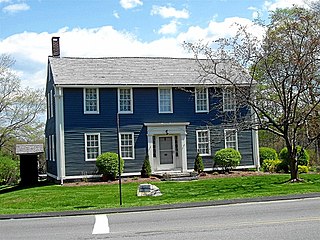
The William Williams House is a historic house in Lebanon, Connecticut at the junction of Connecticut Routes 87 and 207, a National Historic Landmark. It is significant as the residence of Founding Father William Williams (1731–1811), who was a delegate from Connecticut Colony to the Continental Congress and a signer of the Declaration of Independence. Williams lived here from 1755 until his death, and it is a well-preserved and little-altered colonial-era house.
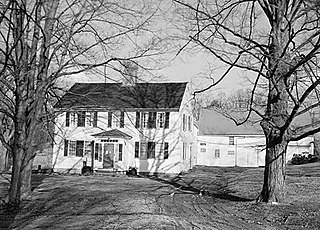
The John Sullivan House is a historic house at 21 Newmarket Road in Durham, New Hampshire. A National Historic Landmark, it was the home of American Revolutionary War General John Sullivan (1740-1795), who later became President of New Hampshire.

The Josiah Bartlett House is a house in Kingston, New Hampshire. The 2+1⁄2-story wood-frame house is located on Main Street, opposite Town Hall. The main block of the house, five bays wide and three deep, was built in 1774 by U.S. Founding Father Josiah Bartlett, replacing a house which was destroyed by fire. During the first decades of the 19th century, Greek Revival styling was added to the house, as was a two-story addition to the rear. The Greek Revival elements include large corner pilasters, projecting lintels over some of the windows, and the front door surround, which has pilasters and a cornice.

The Moffatt-Ladd House, also known as the William Whipple House, is a historic house museum and National Historic Landmark in Portsmouth, New Hampshire, United States. The 1763 Georgian house was the home of William Whipple (1730–1785), a Founding Father, a signer of the Declaration of Independence and Revolutionary War general. The house is now owned by the National Society of Colonial Dames in New Hampshire, and is open to the public.

Summerseat, also known as the George Clymer House and Thomas Barclay House, is a historic house museum at Hillcrest and Legion Avenues in Morrisville, Bucks County, Pennsylvania. Built about 1770, it is the only house known to have been owned by two signers of the United States Declaration of Independence, Founding Fathers George Clymer and Robert Morris, and as a headquarters of General George Washington during the American Revolutionary War. The house is now managed by the Morrisville Historical Society, which offers tours. It was designated a National Historic Landmark in 1965.

The Nash-Hooper House, also known as the William Hooper House, is a historic house at 118 West Tryon Street in Hillsborough, North Carolina. Built in 1772 by American Revolutionary War general Francis Nash, it was home from 1782–1790 to Founding Father William Hooper, a signer of the United States Declaration of Independence. It is the only known home of Hooper's to survive, and was declared a National Historic Landmark in 1971. It is located in the Hillsborough Historic District; it is a private residence, and is not normally open to the public.

The Heyward-Washington House is a historic house museum at 87 Church Street in Charleston, South Carolina. Built in 1772, it was home to Thomas Heyward, Jr., a signer of the United States Declaration of Independence, and was where George Washington stayed during his 1791 visit to the city. It is now owned and operated by the Charleston Museum. Furnished for the late 18th century, the house includes a collection of Charleston-made furniture. Other structures include the carriage shed and 1740s kitchen building.

Maybury Hill is a historic house at 346 Snowden Lane, in Princeton, Mercer County, New Jersey, United States. Built about 1725, it was the birthplace and boyhood home of Joseph Hewes (1730-1799), a signer of the United States Declaration of Independence. The house, an architecturally excellent example of Georgian domestic architecture, was designated a National Historic Landmark in 1971 for its association with Hewes. It is a private residence not open to the public.
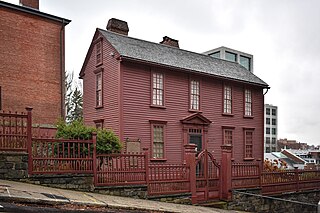
The Governor Stephen Hopkins House is a museum and National Historic Landmark at 15 Hopkins Street in Providence, Rhode Island. It was the home of Stephen Hopkins, a governor of the Colony of Rhode Island and Providence Plantations and a signer of the Declaration of Independence.

College Hill, also known as George Walton House, Harper House, or Walton-Harper House, is a historic house at 2116 Wrightsboro Road in Augusta, Georgia. It was built in 1795, and was the home George Walton, a signer of the United States Declaration of Independence, from then until his death in 1804. It was declared a National Historic Landmark in 1971. It is a private residence, and is not open to the public.

Meadow Garden is a historic house museum at 1320 Independence Drive in Augusta, Georgia. It was a home of Founding Father George Walton (1749–1804), one of Georgia's three signers of the U.S. Declaration of Independence. Walton was later elected governor of Georgia and also served as a United States senator. Meadow Garden was saved by the Daughters of the American Revolution, who established it as a museum in 1901. The house was declared a National Historic Landmark in 1981.

The Signer's House and Matthew Thornton Cemetery are a pair of historic properties in Merrimack, New Hampshire, United States. It consists of a house, once owned by Matthew Thornton, a signer of the United States Declaration of Independence, and the adjacent cemetery in which he is buried. The house is a two-story Georgian style double house, and is the only surviving house of the period in Merrimack. It was owned by Thornton from 1780 to 1797, when he sold it to his son James. The cemetery, located across the Daniel Webster Highway from the house, is also Merrimack's first cemetery, with the oldest gravestone marked 1742.























